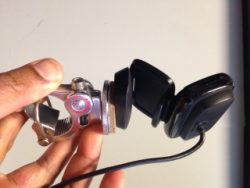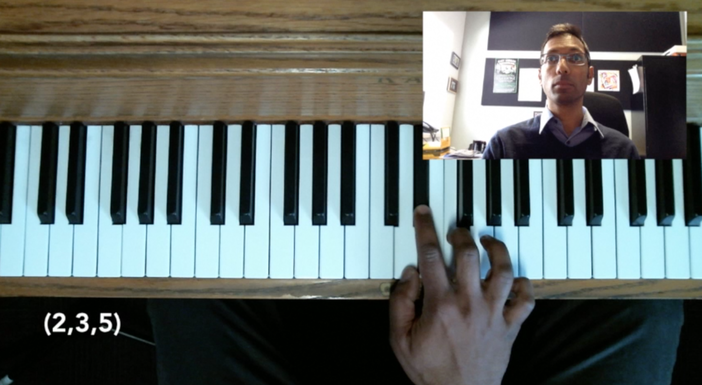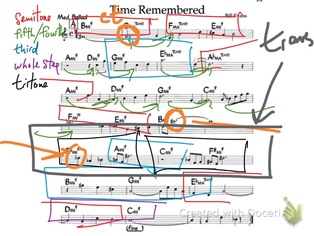Opportunity
The School of Creative and Performing Arts at Humber College in Toronto offers its music students an array of face-to-face classroom courses, including one with a hybrid segment. Professor Shirantha Beddage, Director of Theory and Harmony, Humber Music, teaches both face-to-face and hybrid courses, and when he saw the challenges faced by students learning the theoretical and practical elements of performance, he crafted new instructional tools using technology and some common household items.
Innovation
The Piano-Cam:
Humber’s Contemporary Music Theory and Improvisation 3/4 course, which includes a hybrid segment, is reserved for students with a strong theory background who performed well in the first-year Music Theory course. While most of the Music Theory courses run for two face-to-face periods, twice a week, Professor Beddage’s section of the course runs for two periods, once a week. In place of the second classroom day, Professor Beddage posts a weekly module on Humber’s Blackboard learning management system, introducing new topics through his own previously prepared videos, and sharing handouts and links. This information combines with the course textbook to give students the fundamental information required. Students work through the materials at their own pace and submit assignments, quizzes and other requirements online.
For the most part, the application of information is reserved for in-class sessions, where Professor Beddage spends considerable time demonstrating concepts by playing the piano. When he realized students would learn more effectively by seeing his hands on the keyboard, he began experimenting with ways to make this possible. After several false starts, he created the “Piano-Cam” by attaching a Logitech C615 webcam to a boom mic stand with a bicycle tripod mount. Positioned above Professor Beddage’s keyboard, the device projects onto a screen in the face-to-face classroom and in online lectures for the hybrid segments. The boom mic is adjustable, allowing various points of view.


The Piano-Cam allows students who are visual learners, and those without perfect pitch or who are not pianists, to see specific notes and chords Professor Beddage plays. It also allows students to experience the hands-on, practical applications of the concepts he teaches in real time, while encouraging them to practice on their own. In addition, Professor Beddage uses the Piano-Cam to create the tutorial videos he posts on Blackboard, allowing students to review difficult concepts as many times as required, and allowing instructors from other sections to use the videos as resources in their courses.

iPads and Apps:
For his face-to-face Music Theory classes, Professor Beddage conducted a lengthy search to replace the outdated overhead projector with something to analyze sheet music containing functions, Roman numerals and other symbols. Now, when students enter his classroom with their compositions, he photographs the sheets of music with his iPad using “forScore,” an application that reads, stores and organizes music. He then makes detailed analyses of the compositions in real time using the same program. An app called “Doceri” allows him to control the many PowerPoints on his laptop remotely and make annotations as he goes along. Doceri automatically records his individual annotations so he can post presentations to Blackboard after class, and it records audio, allowing him to screencast his lectures with no additional effort. Professor Beddage also authors additional tutorial videos using the whiteboard app "Explain Everything."

The “AirServer” app allows Professor Beddage to project his students’ compositions onto a screen while making annotations during his verbal critique. Because it is a wireless transfer system, AirServer frees Professor Beddage from a podium, allowing him to interact with students individually in the classroom. Students, in turn, can see each other’s work and participate in the process of making music in a visual, kinaesthetic and aural way.
After implementing live annotation on images, Professor Beddage turned his attention to finding an app allowing him to do the same to video footage of students learning to conduct in his fourth year Music Pedagogy course. The solution was Coach’s Eye, originally designed to allow sports team coaches to record athletes and replay the video frame-by-frame, annotating as they go. Professor Beddage uses this technology to provide instant commentary on a student’s body alignment and technique.
Outcomes and Benefits
Professor Beddage’s teaching reflects his belief that no two students are alike in terms of their experience, interests and learning styles. Since rethinking his methods and implementing his technology-based techniques, the feedback from students suggests these new methods are helping them learn in more holistic and practical ways. He sees this learning informing their musicianship skills on their instruments. The technology has not fundamentally changed Professor Beddage’s thinking on teaching, but it has made it easier for him to deliver a variety of content in the classroom, which has resulted in increased student engagement and group collaboration.
Challenges and Enhancements
Professor Beddage structures his classes to optimize a “flow” for himself and his students. This allows him to create a narrative arc through each lesson, in much the same way he tries to create a narrative when improvising or composing music. Technology can help him achieve this flow, but it can also be a hindrance if he incorporates too many tools into a lesson, or if the technology fails to work as intended. Professor Beddage admits when he first began his technological teaching experiments, he often overused the technology, which frustrated him and occasionally confused his students. By considering his lesson objectives, he learned to limit the number of tools he used. This focus now helps him remain calm in class and prepares him to resort to low-tech teaching methods when the high-tech methods aren’t working.
The small number of students with complaints about the technology generally refer to either the pace of the class or the awkwardness of the online environment, and Professor Beddage agrees some concepts are somewhat easier to understand in a face-to-face context.
Professor Beddage’s greatest challenge in teaching his Music Theory course is helping students see its usefulness and relevance. “My students are used to getting their hands dirty in a performance setting, and for many of them the terms and systems used in Music Theory are a hard sell, because they don’t always see them as useful learning tools. That said, my students generally report the online videos I’ve created have allowed them to understand the concepts at a deeper level, because they can review and re-watch the videos at their own pace.” Although he has limited quantitative data, he believes his use of iPad apps “helps enrich and enhance” his students’ learning.
Potential
Professor Beddage believes any technology allowing greater collaboration has the potential to enhance the classroom environment. “My dream is to make the online environment as interactive and engaging as the classroom environment. Though I’ve received extremely positive feedback from students regarding my online videos in particular, they are, of course, part of a largely one-directional learning process. There’s a certain sense of detachment I feel when communicating online, and I doubt I’m alone in this feeling. If the circumstances were correct, I would love for the online classroom environment to be as close to a face-to-face group lesson as possible, allowing for more collaboration, participation and enrichment.”
Professor Beddage hopes his approach to teaching will encourage other educators to seek out and apply available tools to their own disciplines in an effort to create a fuller and more diverse learning experience for their students. He continues to explore the “amazing” potential of tablet-based education as developers create new software directly impacting teaching in the digital age.
For Further Information
Professor Shirantha Beddage
Director of Theory and Harmony
Humber Music, School of Creative and Performing Arts, Humber College
[email protected]
Bachelor of Music Program, Humber College


